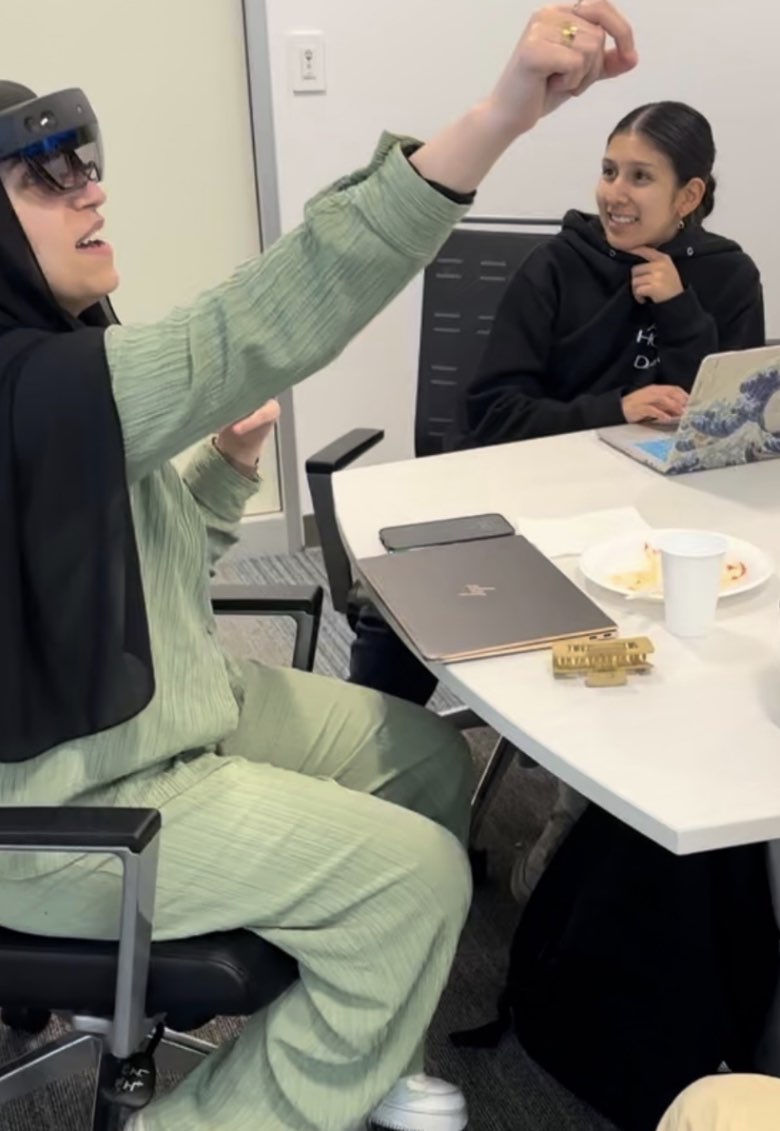Research Project
iPUMP: AR and Breast Pumps
(Breastfeeding Reimagined: Exploring Augmented Reality’s Impact on Lactation, Maternal Health, and Well-Being)
Research Team
Lead Researchers:
- Dr. Kacie Blackman, Ph.D., Associate Professor
Internal Collaborators:
- Thomas Chan
Student Team:
- Monica Ahumada-Heen*
- Andrea De Leon*
- Simran Patel*
- Mohith Kanthamneni*
- Linduli Weerasinghe*
- Jasmine Garcia*
- Henny Patil*
- Kate Gregg*
- Mahi Morou*
- Briana Ramirez*
- Toni Walker*
- Alishia Sandoval, B.S. Student in Computer Science
- Brenda Simonian
- Caitlynn Thomas
- Denise Jimenez
- Destiny Varela
- Duaa Mohammed Shameem
- Harmony Whiting
- Kira Faerstain
- Malak Elokour
- Pauline De La Cruz
Note: names marked with an asterisk (*) indicate current students
Funding
- Funding Organizations:
- 2024-2025 CSUN Research, Scholarship, and Creative Activity (RSCA)
- 2023-2024 CSUN Health & Human Development Innovation & Collaboration Challenge
- Charles R. Drew University Black Maternal Health Center of Excellence Biddy Mason Fellowship
SYNOPSIS
- The benefits of breastmilk include growth plus physical and
mental development. - Many breastfeeding parents must return to work during the first year of their child’s life, so use a breast pump to express breast milk. It is stored for a future bottle-feeding session to help maintain an adequate supply.
- Innovative methods to enhance breastfeeding are needed to expand these benefits in the US.
- The proposed app, Augmenting Milk Output Realities (AMOR), amplifies the breast pumping experience by completely immersing the parent with a carousel of pictures of her baby that she can interact with using hand gestures.
Abstract
interventions of tablet and augmented reality applications. We aim to recruit, enroll, and randomly assign 40 breastfeeding persons to test out the app (20 in the tablet control group and 20 in the AR group). Qualitative (e.g., open-ended questions), and quantitative (e.g., emotional and cognition states, usability, volume of milk, efficiency (volume (ml) x time (mins)) data types will be collected to gain a greater understanding of the user experience in augmented reality. The ultimate goal is to gather data to apply for funding and refine the development of augmented reality applications to improve health outcomes in postpartum mothers and their babies. This is a multi-site research study CSUN campus (Lilac Hall) and Charles R. Drew University (Maternity House, lactation pod in south Los Angeles, and maternity house in Antelope Valley).


Research Questions and Research Objectives
-
To measure changes in saliva during a breast pumping session with a selected visual device, and to determine the effects of AMOR’s intervention on breast milk expression, salivary oxytocin (which makes milk available: letdown reflex), and user experience.
-
The project’s expected outcomes include that the Intervention Group (using augmented reality) will have a greater volume and mass of expressed breast milk.
Research Methods
-
Participants provide personal images of their baby and family that are loaded onto a study visual device.
-
Participants then view their images during their breast pumping session.
-
At the participant’s third visit, and based on random assignment, they will either continue with a tablet or will use an augmented reality device to view and interact with their images as they utilize a breast pump to express breast milk.
Research Deliverables and Products
- 22 participants have been randomly assigned to receive an AMOR app intervention (AR device, n=14 participants) or a control condition (tablet, n=8 participants).
- The AMOR app incorporated 60 photos (self-portraits, pictures with their baby/family) that the participant selected into an immersive AR experience that targeted salivary oxytocin.
- The AMOR app users’ experience (time points 1 and 2) was significantly better when compared to tablet app users’ experience at time points 1 and 2 (95% CI = 0.40 to 0.87, t = 5.71, p<0.001).
Commercialization Opportunities
-
Application: May be utilized by breastfeeding parents who may be away from their baby for extended periods.
-
Key Values: Engaging and customizable experience for lactating mothers.
-
Potential Customers: Hospitals, incarceration facilities, lactation consultants, perinatal doulas, the Department of Defense
Research Timeline
Start Date:01/02/2023
End Date: 06/30/2025
Research Team
Lead Researchers:
- Dr. Kacie Blackman, Ph.D., Associate Professor
Internal Collaborators:
- Thomas Chan
Student Team:
- Monica Ahumada-Heen*
- Andrea De Leon*
- Simran Patel*
- Mohith Kanthamneni*
- Linduli Weerasinghe*
- Jasmine Garcia*
- Henny Patil*
- Kate Gregg*
- Mahi Morou*
- Briana Ramirez*
- Toni Walker*
- Alishia Sandoval, B.S. Student in Computer Science
- Brenda Simonian
- Caitlynn Thomas
- Denise Jimenez
- Destiny Varela
- Duaa Mohammed Shameem
- Harmony Whiting
- Kira Faerstain
- Malak Elokour
- Pauline De La Cruz
Note: names marked with an asterisk (*) indicate current students
Funding
- Funding Organizations:
- 2024-2025 CSUN Research, Scholarship, and Creative Activity (RSCA)
- 2023-2024 CSUN Health & Human Development Innovation & Collaboration Challenge
- Charles R. Drew University Black Maternal Health Center of Excellence Biddy Mason Fellowship
